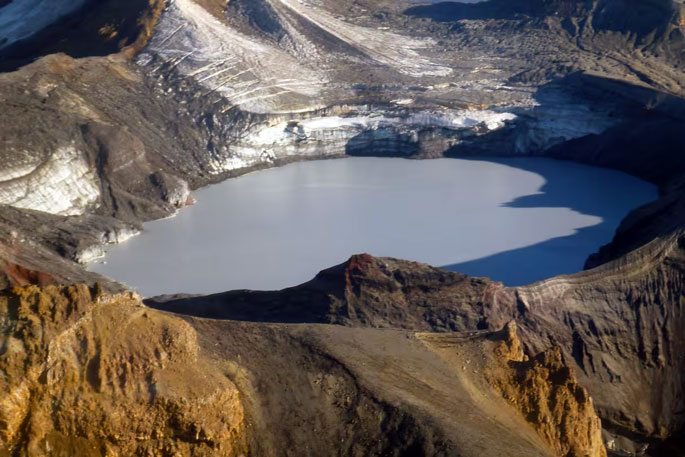Mt Ruapehu’s famous crater lake has cooled to record levels, indicating the hydrothermal system beneath it is partly blocked, scientists say.
While eruptions have sometimes occurred when that’s happened – most recently in 2007 – a surprise blow is still considered unlikely.
In the latest development in a year of unrest at the 2800m-high stratovolcano, sensors within the lake this week registered temperatures of just 6.83C.
That was the coldest reading since measurements began there in the 1950s and well down on the 31C peak temperature observed in mid-February.
“The last time we measured a lake temperature below 10C was in November 1988,” GeoNet duty volcanologist Dr Yannik Behr said.
The lake cooled to 11C last month, and Behr said the further drop likely owed to low heat flow coming into the lake from below and snowstorms adding more cold water from the top.
While the amount of sulphur dioxide volcanic gas passing through the lake has also dropped sharply since summer, observations indicated the system wasn’t completely blocked.
In the past, blockages have preceded three eruptions – in 1981, 1988 and 2007 – but in most cases, a new heating cycle began without an event.
“While eruptions are possible from a partially sealed hydrothermal system it would likely require more magmatic activity.”
There had been few tell-tale signals of that as levels of gas emissions and volcanic tremor continued to run low and there’d been no notable changes in ground deformation.
“Eruptions are much more likely when we have signs of magma coming close to the surface or more gas being released from depth – such signs include increased volcanic tremor, high gas emissions, and a hot lake.”
As such, GeoNet hadn’t raised Ruapehu’s Volcanic Alert Level above 1, which indicated minor unrest.
“In other words, the volcano is not more active at the moment, it is just a little more ‘blocked’,” Behr said.
“This, in itself, is not a problem but could be aggravating should we have more magmatic activity and gas trying to rise from depth while it is more blocked.”
Behr encouraged people visiting or living around the volcano to keep up to date with the volcano’s activity and follow recommendations from agencies.
“Ruapehu is an active volcano and can erupt with little or no warning.”
While an eruption now would likely be a small one, the area around the crater lake would be particularly hazardous: 2007′s quick-fire blast nearly killed a pair of climbers who were near the summit.
“Another hazard from a small eruption would be a lahar flowing down the slopes of the mountain.”
- Mt Ruapehu’s crater lake this week registered 6.83C – the coldest temperature in seven decades of monitoring
- Scientists suspect the hydrothermal system beneath the lake is partially sealed
- But they think an eruption is still unlikely, with few indicators of “magmatic activity”



2 comments
The Master
Posted on 20-09-2024 15:04 | By Ian Stevenson
The SO2 and heat will not have gone away, it is merely capped of for now...
The question then, logically, that follows is when and where will it reappear?
Sooner of later it must, the longer that takes the bigger the discharge will be then. Maybe no immediate risk, but this is and has always been a "when question" not an "if".
The Master
Posted on 20-09-2024 15:06 | By Ian Stevenson
Above it says "they think an eruption is still unlikely, with few indicators of “magmatic activity”...
maybe there is no signs as yet because as also noted above its capped off all by itself... so what happens to a bottle of bubbles when the cap flicks off? BOOM!!!
Leave a Comment
You must be logged in to make a comment.